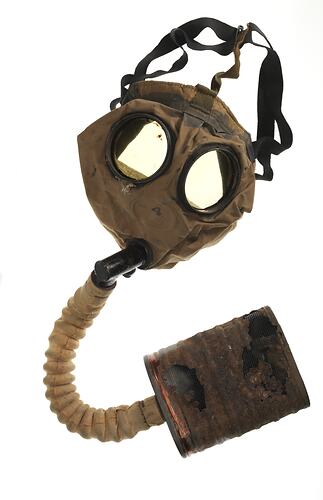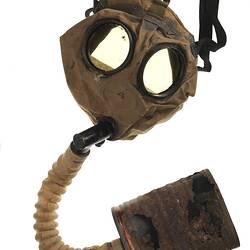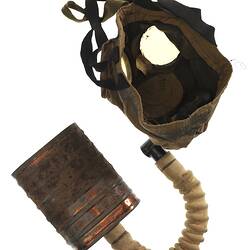Summary
Alternative Name(s): Gas Mask, Box Respirator, Gas Respirator
British World War I small box respirator with haversack, inscribed '1917'. The respirator was apparently made by Waring & Gillow Ltd, which made respirators in London during the War, as well as ammunition belts, protective clothing for use during gas attacks, trench covers, tents and nosebags for horses. (Before the War the company was known as a furniture manufacturer.)
The respirator was described as having been 'captured' during World War I - although it is British-made and markings indicate it was used by an Australian soldier, Lieutenant H. Albion.
Henry Alfred Laurence Allibon (Service No. 8161) was a 24 year old clerk from Deniliquin, NSW at the time he enlisted in the AIF on 7 July 1915. He served with the 2nd Australian General Hospital, moving to France in April 1916. In early 1918 he started officer training and qualified for a commission in August that year. He suffered from bronchitis and sustained a non-military injury, but survived the war relatively unscathed. After returning to Australia, Allibon was the secretary of the Australian Automobile Chamber of Commerce based in Melbourne and general secretary of the Victorian Automobile Chamber of Commerce in the 1940s and early 1950s.
The small box respirator was first used for allied troops on the Western Front in 1916. It was considered to be the most effective gas mask of the war, with features including an internal nose clip (although very uncomfortable for long-term wear) and an internal mouth piece, meaning that the face mask did not need to be air-tight. Only inhaled air had to pass through the canister, extending the canister's life. The contents of the canister were changed over time - by 1918 it contained gauze mesh, with wood charcoal and soda lime (proportioned 3:2) in layers separated by cotton pads. (Australian War Memorial)
Physical Description
Box respirator comprising face mask, canister and haversack. The face is rubberized cloth, with yellow plastic (celluloid) eye lenses, and elasticised straps and a cloth tape to hold mask onto the head. Connects via a cloth-covered hose to a chemical absorbent canister. Separate haversack with shoulder strap, divided into two compartments. Inside the smaller compartment base is a metal coil, linked to a long woven string that is attached to the mouth of the compartment.
More Information
-
Collecting Areas
-
Acquisition Information
Donation from (Estate of) H. A. Allibon, Victoria, Victoria: State War Trophy Committee, 21 Aug 1969
-
Manufacturer
Waring and Gillow Ltd, England, Great Britain, 1917
Date based on inscription. -
User
-
Inscriptions
Marked 'F27 R122' & 'K 84 4'. Haversack marked '- (illegible - could be Waring) & Gillow Ltd. 1917' and ': Lt. H. A. L. Allibon 5 Bn A. I. F.' Has broad arrow symbol.
-
Classification
-
Category
-
Discipline
-
Type of item
-
Overall Dimensions
600 mm (Length), 170 mm (Width), 170 mm (Depth), 160 mm (Height)
Dimensions of respirator. Dimensions of haversack: W: 280; H: 260; D: 80mm. Dimensions of respirator on display 160h x 360w x 380d
-
References
Information on Waring & Gillow from [Link 1] accessed 9/7/2013. Information on box respirators in World War I from the Australian War Memorial web site [Link 2] accessed 17/7/2013.
-
Keywords
Gas Masks, Militaria: British, Respirators, World War I, 1914-1918, Gas Warfare


